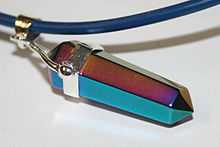Aqua aura

Aqua aura is a natural crystal that has been coated with gold fumes.[1] It is created in a vacuum chamber from quartz crystals and gold vapor by a process known as vapour deposition.[2] The quartz is heated to 871 °C (1600 °F) in a vacuum, and then gold vapor is added to the chamber. The gold atoms fuse to the crystal's surface, which gives the crystal an iridescent metallic sheen. The process was awarded the United States Patent No. 6997014 on 14 February 2006.[3]
When viewed under a gemological microscope in diffused direct transmitted light, Aqua Aura displays the following properties:[4]
- A coppery surface iridescence in tangential illumination
- Diffused dark outlines of some facet junctions
- A patchy blue colour distribution on some facets
- White facet junctions, irregular white abrasions and surface pits, where the treatment either did not "take" or had been abraded away.
Additional elements can be used to treat quartz, such as indium, titanium, and copper. The coloring of this treatment is only on the surface, so all faceted and polished material you find has been treated after it has been made originally. Often, quartz of lesser quality, with fractures and weak spots, will break apart during the coating process.[5]
Flame Aura

Flame Aura or Rainbow Aura Quartz have been enhanced with a combination of titanium and niobium. Titanium molecules are bonded to the quartz by the natural electrostatic charge of the crystal in a process known as magnetron ionization. The brilliant color of Flame Aura is the result of optical interference effects produced by layers of titanium. Since only electricity is used to deposit the titanium layers and create these colors, very little heat is involved and the integrity of the crystal is maintained. The crystal does not become brittle or prone to breakage as with other enhancements. If it does however, the natural color of the stone will show through because the enhancement is only on the surface of the crystal.
See also
References
- ↑ Aqua Aura: Aqua Aura mineral information and data
- ↑ The Illustrated Dictionary of Geology By Cindy Jones - Page 16 (Google Books Link)
- ↑ http://www.google.com/patents?id=x213AAAAEBAJ&dq=6997014
- ↑ Gems: Their Sources, Descriptions and Identification By Robert Webster, Michael O'Donoghue (Google Books)
- ↑ Zzyzx, Justin. "Coatings on Minerals". DyeingAgates.com. Forty Seven Press. Retrieved 10 December 2012.